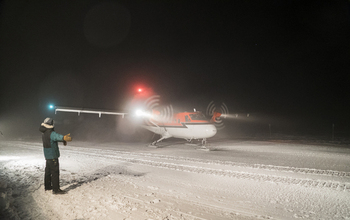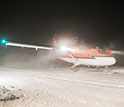News Release 16-079
Ailing Antarctic personnel transported to safety
Meticulously planned, carefully executed, NSF-led medical evacuation results in successful patient transport despite extreme conditions

The arrival completes a nine-day, global evacuation operation that NSF coordinated.
June 23, 2016
This material is available primarily for archival purposes. Telephone numbers or other contact information may be out of date; please see current contact information at media contacts.
Two people stationed at the National Science Foundation’s (NSF) Amundsen-Scott South Pole Station have arrived safely in Punta Arenas, Chile, for medical treatment.
The arrival completes a nine-day, global evacuation operation that NSF coordinated to prioritize the health and safety of station and rescue personnel.
"NSF is committed to supporting scientific exploration -- which often requires researchers and support staff working in some of the most inhospitable places on the planet -- but our top commitment is to the safety and security of the people involved in those endeavors," said NSF Director France Córdova. "This was a difficult process, and we're especially grateful to the skilled flight crew who flew almost halfway around the world and over three continents, for the South Pole Station winter crew, and all the dedicated people who facilitated this rescue. It has served as a sobering reminder of the risks research often requires, the tremendous challenges involved, and the resolve and solidarity of the scientific community."
Córdova said all of NSF hopes for the swift recovery of the patients.
Prior to the medical evacuation, 48 people were wintering at Amundsen-Scott, one of three year-round stations NSF operates in Antarctica to further the progress of science and do station maintenance.
Because of extreme cold and darkness at this time of year in Antarctica, flights in and out of that station are normally suspended. In this case, in consultation with outside medical experts, NSF determined that an evacuation was warranted and called on Calgary-based Kenn Borek Air Ltd., which has a U.S. government contract to fly in support of U.S. Antarctic Program science, to conduct this mission.
Two Twin Otter aircraft, designed to withstand intense weather conditions, arrived at British Antarctic Survey's Rothera Station on the Antarctic Peninsula on June 20, where they rested and awaited favorable weather. On June 22, one of the aircraft arrived at the geographic South Pole. Later that day, the flight landed safely in Chile.
"I wish to thank the people around the globe who expressed their support for the Kenn Borek pilots, the South Pole community, the British Antarctic Survey and all of our national and international colleagues who contributed to this week's medical evacuation flight," said Kelly K. Falkner, head of the NSF Polar Program.
NSF operates the Amundsen-Scott South Pole Station as part of its management of the U.S. Antarctic Program, the nation's research program on the southernmost continent.
NSF will not release further personal or medical information to preserve patient privacy.
-NSF-
-
View Video
South Pole Evacuation
Credit and Larger Version
For more information about the NSF Antarctic program, visit NSF.gov.
Media Contacts
Peter West, NSF, (703) 292-7530, email: pwest@nsf.gov
Related Websites
Antarctic medical evacuation flight arrives at British Rothera Station: http://www.nsf.gov/news/news_summ.jsp?cntn_id=138999&org=NSF&from=news
The U.S. National Science Foundation propels the nation forward by advancing fundamental research in all fields of science and engineering. NSF supports research and people by providing facilities, instruments and funding to support their ingenuity and sustain the U.S. as a global leader in research and innovation. With a fiscal year 2023 budget of $9.5 billion, NSF funds reach all 50 states through grants to nearly 2,000 colleges, universities and institutions. Each year, NSF receives more than 40,000 competitive proposals and makes about 11,000 new awards. Those awards include support for cooperative research with industry, Arctic and Antarctic research and operations, and U.S. participation in international scientific efforts.
Connect with us online
NSF website: nsf.gov
NSF News: nsf.gov/news
For News Media: nsf.gov/news/newsroom
Statistics: nsf.gov/statistics/
Awards database: nsf.gov/awardsearch/
Follow us on social
Twitter: twitter.com/NSF
Facebook: facebook.com/US.NSF
Instagram: instagram.com/nsfgov



